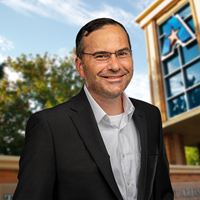New STEM Education Center Creates a Research Hub at UTA
 A new space for STEM education research and collaboration is launching at the University of Texas at Arlington.
A new space for STEM education research and collaboration is launching at the University of Texas at Arlington.
Housed within the UTA College of Education, the new STEM Education Research Collaboratorium and Resource Center - STEM-E(RC)2 - will help education researchers address questions about the nature and outcomes of education programs in the fields of science, technology, engineering, and mathematics – while also helping teachers, universities, school districts, and other education stakeholders refine educational programming in ways that will enhance student learning and engagement.
“UTA is optimally positioned to be a leader in STEM education research,” said Cory T. Forbes, Ph.D., who serves as the center’s inaugural director.
“Our institution is a beacon for research, as indicated by our Carnegie R1 and Texas Tier One designations,” he continued. “Among education professionals, it is common for a curriculum and instruction program to have math and science education specialists; however, it is less common for that to exist in STEM departments. We’re helping to build that infrastructure and enhance STEM education research across the K-16 continuum.”
Dr. Forbes, who joined the College of Education this fall as its Fenton Wayne Robnett Endowed Professor of Science Education and chair of the college’s Department of Curriculum and Instruction, is using funds from a University of Texas System STARs Award to help support the initiative. The STARs Award was created by the UT System to attract field-leading faculty to system institutions like UT Arlington and to assist their research. 
The funding will support renovating, furnishing, and equipping a physical space in UTA’s Trimble Hall for the center – creating a dedicated area for on-campus and external education professionals to plan and execute impactful STEM education research.
Among the plans, the space will include a meeting room with a high-resolution display wall and video conferencing capabilities, zones for participant interviews and focus groups, and space for classroom labs, as well as workstations for student research assistants and data collection equipment.
"Our aim is to help UTA STEM education researchers study what works well and why it works,” Forbes added. “For instance, there could be a biology professor who has responsibility to move a large course beyond a traditional, lecture format, and then those efforts could be assessed.”
Outside of academia, the center can help improve learning outcomes within traditional K-12 classrooms or public settings such as museums and youth or adult outreach activities.
Ultimately, Forbes, said the goal is to “cultivate a research environment that incorporates contemporary best practices in STEM education to enable implementation of innovative educational approaches that can be studied on-site and then shared with science, technology, engineering, and math educators who want to reimagine the future of student learning.”